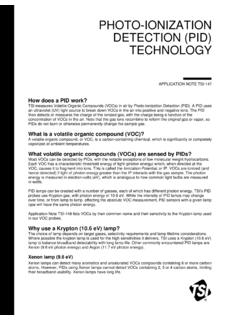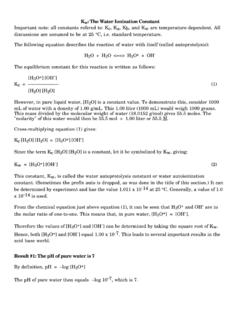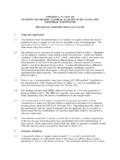Transcription of Elemental Analysis of Organic Species with Electron ...
1 Elemental Analysis of Organic Species withElectron ionization high - resolution MassSpectrometryAllison C. Aiken, , Peter F. DeCarlo, , and Jose L. Jimenez*, , Department of Chemistry and Biochemistry (UCB 215), Cooperative Institute for Research in the Environmental Sciences(CIRES, 216 UCB), and Department of Atmospheric and Oceanic Sciences (311 UCB), University of Colorado, Boulder,Colorado 80309We present a new Elemental Analysis (EA) technique fororganic Species (CHNO) that allows fast on-line Analysis (10 s)
2 And reduces the required sample size to 1 ng, 6 orders of magnitude less than standard composition of the analyzed samples is approximatedby the average Elemental composition of the ions fromhigh- resolution Electron ionization (EI) mass spectra. EAof Organic Species can be performed on Organic /inorganicmixtures. Elemental ratios for the total Organic mass , suchas oxygen/carbon (O/C), hydrogen/carbon (H/C), andnitrogen/carbon (N/C), in addition to the Organic massto Organic carbon ratio (OM/OC), can be determined.
3 Asdeviations between the molecular and the ionic composi-tion can appear due to chemical influences on the ionfragmentation processes, the method was evaluated andcalibrated using spectra from 20 compounds from theNIST database and from 35 laboratory standards sampledwith the high - resolution time-of-flight aerosol mass spec-trometer (HR-ToF-AMS). The Analysis of AMS (NIST)spectra indicates that quantification of O/C is possiblewith an error (average absolute value of the relative error)of 30% (17%) for individual Species .
4 Precision is muchbetter than accuracy at(5% in the absence of air for AMSdata. AMS OM/OC has an average error of 5%. Additionalcalibration is recommended for types of Species verydifferent from those analyzed here. EA was applied toorganic mixtures and ambient aerosols (sampled at 20 sfrom aircraft). The technique is also applicable to otherEI-HRMS measurements such as direct injection Analysis (EA) of complex Organic mixtures (C, H,N, O) is of interest in many fields such as environmental and foodchemistry.)
5 Traditional EA generally requires a few milligrams ofsample and 10 min per sample Analysis . Thermal methods arethe most common type of EA for CHN Analysis , which decomposethe sample using high -temperature oxidation followed by thermalconductivity content must be measuredseparately using pyrolysis and reduction of the sample,1addingadditional instrument reconfiguration and Analysis time. Fororganic/inorganic mixtures, either the sample needs to besubjected to some type of separation (which could introducebiases)
6 , inorganic Species need to be analyzed separately for everysample, or the results obtained will average both types of these techniques were designed for off-line Analysis , timeresolution was not a to the limitations of existing Organic EA techniques, thedevelopment of new techniques that require much smaller samplesand provide much faster Analysis is of great interest in, forexample, environmental analyses. One potential method is to usethe Elemental composition of the ions formed from electronionization (EI) high - resolution mass spectrometry (HRMS), whichis very fast and sensitive, to approximate the composition of themolecules analyzed.
7 This potential technique has not beenexplored to our knowledge, which may be due to the lack ofwidespread availability of HRMS instruments until recently andalso to the perception of widespread chemical biases in thefragmentation ,3 After a molecule is ionized into a positiveion, it may undergo one or several fragmentation reactions, eachproducing an ion and a neutral fragment. Various chemicalproperties such as ionization potential, ion and neutral stability,etc., as well as kinetic effects influence the pathways of fragmenta-tion reactions,2which could lead to biases between the molecularand the ion Elemental compositions, , if electronegative groupspreferentially become the neutral fragment rather than a positiveion during aerosols are one type of environmental sample thatis currently receiving considerable attention from the scientificcommunity.
8 Aerosols are responsible for important effects onclimate, health, and visibility,4and Organic Species comprise alarge fraction of the mass at most are an exampleof a complex Organic mixture found in the environment for which* Author to whom correspondence should be addressed. Department of Chemistry and Biochemistry. Cooperative Institute for Research in the Environmental Sciences (CIRES). Department of Atmospheric and Oceanic Science.(1) Skoog, D. A.; Holler, F. J.; Nieman, T.
9 Of instrumental Analysis ,5th ed.; Saunders College Pub.: Orlando, FL, 1998.(2) McLafferty, F. W.; Turecek, of mass spectra, 4th ed.;University Science Books: Mill Valley, CA, 1993.(3) McLafferty, F. W. Personal communication, 2006.(4) Seinfeld, J. H.; Pandis, S. chemistry and physics : from airpollution to climate change, 2nd ed.; Wiley: Hoboken, NJ, 2006.(5) Zhang, Q.; et Res. ,34, ,79,8350-83588350 Analytical Chemistry, Vol. 79, No. 21, November 1, CCC: $ 2007 American Chemical SocietyPublished on Web 10/04/2007standard chemical Analysis techniques such as GC/MS can onlyidentify a small fraction ( 10%) of the total Species mass spectrometer (AMS)
10 Has become a de facto standard for studying ambient aerosol size-resolved compositiondue to its ability to quantitatively characterize submicrometernonrefractory particles with high sensitivity and time and spectra of standards have been shown to besimilar to those from EI databases, albeit with more ,11 The most notable difference is the greatly enhancedintensity of the CO2+ion for Species such as carboxylic acids inthe AMS, likely due to pyrolysis occurring on the recently developed high - resolution time-of-flight AMS (HR-ToF-AMS),12elemental composition of Organic ions can be directlydetermined, especially for the lowerm/z(<100)





